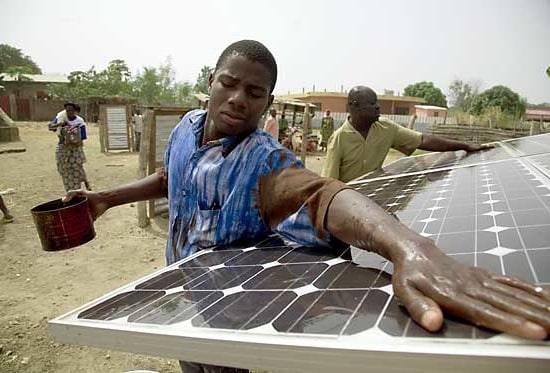Zambia is currently in the midst of the worst drought the country has faced ever. Partly due to the El-Niño weather cycle, the lack of water has severely affected large swathes of the country notably in the southern regions where rainfall is particularly low. In order to fight dramatic consequences of drought on Zambia’s most affected regions in 2015 the government focused on sun as a resource to help address the crisis by developing solar technology.
The case of Kanzungula’s solar powered pumps
Kazungula is a rural district located in the country’s far south. Its parched lands saw only 40mm of rain fall between November 2015 and January this year. Zambia’s Climate Chance Secretariat (CSS) identified Kazungula as an area in desperate need of attention which represented an ideal testing ground for a new solar powered scheme. Three new solar installations were built throughout Kazunglula as part of the project. Solar powered schemes involved drilling a borehole 50-60 meters deep into the arid earth to access the water table far below into the ground. Once water struck, a solar powered pump brings clean water to large storage tanks on the surface. The solar array element is critical in this process as it powers reliable water extraction in remote areas with no access to the main grid. For locals in Kazungula, the results have been nothing short of life-changing. Munji Malambo a 16 year old boy who lives in the area said in an interview with Thompson Reuters that “before this (borehole) we used to walk long distances every morning to get water before coming back to go to school […]. Most of the shallow wells in the area had dried up and the closest one was two kilometers away. Sometimes the water would get very dirty and not safe to drink.”
Implications for the future
The success of the Kazungula schemes has prompted plans for 200 installations of solar powered pumps across Zambia that the CSS hopes to complete within two years. According to Zambia’s Ministry of Finance droughtshave costs the economy an estimated US$13.8 billion over the last 30 years. Solar schemes have then turned out to be real value for money to local and national governments. For instance, the three projects in Kazungula cost a mere $6,100 dollars. What’s more, the costs of solar installations have plummeted almost 50% over the last year. Contractors are now bidding to provide solar schemes at lower cost per MW than coal-fired generators, the cheapest historical source of energy. Solar pumping solutions like those recently used in Zambia are now being recognized as a major tool to be utilized across the African continent to fight drought consequences. With the obstacle of price removed solar energy with its many applications is set to proliferate throughout Africa.
Caution and diligence are needed
For nations such as Zambia which rely heavily on hydroelectric plants drought has placed a major strain on power production. As a result there has been a major shift to chopping and burning lumber for energy. Unfortunately this can negatively affect the water system, causing instability to recharge rates while affecting runoff to bodies of water. In the long term solar installations can help to address the energy shortage but major schemes take time to implement. Similarly, oversight is needed to manage borehole schemes themselves. Excessive drilling can cause serious consequences for the long term health of water systems. Water management is complex, and governments need to make sure the correct expertise and regulation is in place. If properly managed solar-pumping projects can become a significant ally to Africa in its fight against drought.

